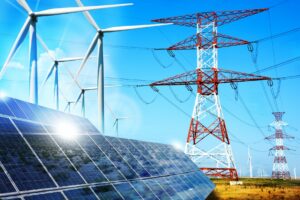 On September 8, 2021, the Department of Energy (DOE) released its Solar Futures Study providing a blueprint for the role of solar energy in decarbonizing the nation’s power sector. The 310-page Study outlines a future in which solar provides 40% of the nation’s electricity supply by 2035 through cost reductions, technological improvement, rapid deployment, and supportive policies. And, with the electrification of buildings and the transportation sector, solar could also power 30% of all building end uses and 14% of transportation end uses by 2050.
On September 8, 2021, the Department of Energy (DOE) released its Solar Futures Study providing a blueprint for the role of solar energy in decarbonizing the nation’s power sector. The 310-page Study outlines a future in which solar provides 40% of the nation’s electricity supply by 2035 through cost reductions, technological improvement, rapid deployment, and supportive policies. And, with the electrification of buildings and the transportation sector, solar could also power 30% of all building end uses and 14% of transportation end uses by 2050.
The Study identifies several policy initiatives needed to support the deployment of solar at this scale, including decarbonization targets, R&D investments and cost reductions, changes to wholesale electricity market regulation, and transmission development, to name a few. In order to meet the 40% by 2035 goal, the Study estimates that the U.S. must install an average of 30 GW of solar capacity per year between now and 2025 and 60 GW per year from 2025-2030, with a total of 1,000 GW of solar deployed by 2035. If the solar industry sees this level of growth, the Study estimates that the industry could employ up to 1.5 million people by 2035. The Study also highlights the important role that battery storage and demand-side management will play given that solar power varies based on daily and seasonal patterns.
With solar power currently providing approximately 3% of the nation’s electricity supply, the DOE’s 40% goal will be contingent on many factors supporting the industry in the coming years, including cost reductions, supportive policies, and widespread deployment.
 In an effort to ensure that owners of solar and wind energy facilities (“renewable energy facilities”) do not decommission production facilities without completing proper reclamation, on April 10, 2021, the West Virginia Legislature enacted Senate Bill 492, creating the West Virginia Wind and Solar Energy Facility Reclamation Act (as new Article 32 of Chapter 22 of the West Virginia Code (“Reclamation Act”)). The Reclamation Act (effective July 9, 2021) generally requires that an owner of a wind generation facility or a solar generation facility submit certain information to the West Virginia Department of Environmental Protection (“DEP”), including the date the facility commenced operation; a proposed decommissioning plan (prepared by a “qualified independent licensed professional engineer”); and a cost estimate for execution of that plan. The DEP will use that and other relevant information in preparing (or approving) a decommissioning plan for the site and in determining an appropriate reclamation bond amount for the facility.
In an effort to ensure that owners of solar and wind energy facilities (“renewable energy facilities”) do not decommission production facilities without completing proper reclamation, on April 10, 2021, the West Virginia Legislature enacted Senate Bill 492, creating the West Virginia Wind and Solar Energy Facility Reclamation Act (as new Article 32 of Chapter 22 of the West Virginia Code (“Reclamation Act”)). The Reclamation Act (effective July 9, 2021) generally requires that an owner of a wind generation facility or a solar generation facility submit certain information to the West Virginia Department of Environmental Protection (“DEP”), including the date the facility commenced operation; a proposed decommissioning plan (prepared by a “qualified independent licensed professional engineer”); and a cost estimate for execution of that plan. The DEP will use that and other relevant information in preparing (or approving) a decommissioning plan for the site and in determining an appropriate reclamation bond amount for the facility.
Click here to read full article.
 On March 25, 2021, the Department of Energy (DOE) announced plans to reduce the cost of solar energy technologies by 60% over the next 10 years by setting new cost targets and establishing funding opportunities. The DOE accelerated its cost target for utility-scale solar by establishing a new goal of driving down the current cost of 4.6 cents per kilowatt-hour (kWh) to 3 cents/kWh by 2025 and 2 cents/kWh by 2030. The DOE also announced $128 million in funding and initiatives aimed at lowering costs, improving performance, and speeding up the deployment of solar energy. Specifically, the DOE announced funding for advancing solar photovoltaic (PV) materials and a prize competition for perovskite technologies, increasing the lifetime of silicon-based PV systems, and supporting several concentrating solar-thermal power projects. The DOE stated that in order to meet the Biden Administration’s goal of 100% clean electricity by 2035, lowering the cost of solar energy technologies is needed to accelerate investment and deployment. More information about DOE’s funding opportunities can be found here: https://www.energy.gov/eere/solar/funding-opportunities
On March 25, 2021, the Department of Energy (DOE) announced plans to reduce the cost of solar energy technologies by 60% over the next 10 years by setting new cost targets and establishing funding opportunities. The DOE accelerated its cost target for utility-scale solar by establishing a new goal of driving down the current cost of 4.6 cents per kilowatt-hour (kWh) to 3 cents/kWh by 2025 and 2 cents/kWh by 2030. The DOE also announced $128 million in funding and initiatives aimed at lowering costs, improving performance, and speeding up the deployment of solar energy. Specifically, the DOE announced funding for advancing solar photovoltaic (PV) materials and a prize competition for perovskite technologies, increasing the lifetime of silicon-based PV systems, and supporting several concentrating solar-thermal power projects. The DOE stated that in order to meet the Biden Administration’s goal of 100% clean electricity by 2035, lowering the cost of solar energy technologies is needed to accelerate investment and deployment. More information about DOE’s funding opportunities can be found here: https://www.energy.gov/eere/solar/funding-opportunities
 The Department of Energy (DOE) recently announced that it will be awarding up to $20Million to support research and development of emerging flow battery storage technology. The DOE’s announcement can be found here. Battery storage has been identified by the DOE as an integral piece of the puzzle to modernizing our grid and enabling the deployment of additional renewable energy resources. Regarding flow battery technology, the DOE stated that “while lithium-ion batteries are commonly used in electric vehicles and portable devices for various applications, flow batteries are particularly well-suited for grid storage needs.” The DOE aims to incentivize development of scalable and cost-effective “mid-sized” flow battery systems (between 10 to 100kWh). This funding opportunity follows several other recent announcements supporting the growth of energy storage, including the DOE’s Energy Storage Grand Challenge, a Department-wide program to accelerate the development, commercialization, and utilization of next-generation energy storage technologies and sustain American global leadership in energy storage, and a recently proposed Federal Bill to introduce a federal tax credit for energy storage, similar to those available to solar and wind projects.
The Department of Energy (DOE) recently announced that it will be awarding up to $20Million to support research and development of emerging flow battery storage technology. The DOE’s announcement can be found here. Battery storage has been identified by the DOE as an integral piece of the puzzle to modernizing our grid and enabling the deployment of additional renewable energy resources. Regarding flow battery technology, the DOE stated that “while lithium-ion batteries are commonly used in electric vehicles and portable devices for various applications, flow batteries are particularly well-suited for grid storage needs.” The DOE aims to incentivize development of scalable and cost-effective “mid-sized” flow battery systems (between 10 to 100kWh). This funding opportunity follows several other recent announcements supporting the growth of energy storage, including the DOE’s Energy Storage Grand Challenge, a Department-wide program to accelerate the development, commercialization, and utilization of next-generation energy storage technologies and sustain American global leadership in energy storage, and a recently proposed Federal Bill to introduce a federal tax credit for energy storage, similar to those available to solar and wind projects.
 On September 8, 2021, the Department of Energy (DOE) released its Solar Futures Study providing a blueprint for the role of solar energy in decarbonizing the nation’s power sector. The 310-page Study outlines a future in which solar provides 40% of the nation’s electricity supply by 2035 through cost reductions, technological improvement, rapid deployment, and supportive policies. And, with the electrification of buildings and the transportation sector, solar could also power 30% of all building end uses and 14% of transportation end uses by 2050.
On September 8, 2021, the Department of Energy (DOE) released its Solar Futures Study providing a blueprint for the role of solar energy in decarbonizing the nation’s power sector. The 310-page Study outlines a future in which solar provides 40% of the nation’s electricity supply by 2035 through cost reductions, technological improvement, rapid deployment, and supportive policies. And, with the electrification of buildings and the transportation sector, solar could also power 30% of all building end uses and 14% of transportation end uses by 2050. In an effort to ensure that owners of solar and wind energy facilities (“renewable energy facilities”) do not decommission production facilities without completing proper reclamation, on April 10, 2021, the West Virginia Legislature enacted Senate Bill 492, creating the West Virginia Wind and Solar Energy Facility Reclamation Act (as new Article 32 of Chapter 22 of the West Virginia Code (“Reclamation Act”)). The Reclamation Act (effective July 9, 2021) generally requires that an owner of a wind generation facility or a solar generation facility submit certain information to the West Virginia Department of Environmental Protection (“DEP”), including the date the facility commenced operation; a proposed decommissioning plan (prepared by a “qualified independent licensed professional engineer”); and a cost estimate for execution of that plan. The DEP will use that and other relevant information in preparing (or approving) a decommissioning plan for the site and in determining an appropriate reclamation bond amount for the facility.
In an effort to ensure that owners of solar and wind energy facilities (“renewable energy facilities”) do not decommission production facilities without completing proper reclamation, on April 10, 2021, the West Virginia Legislature enacted Senate Bill 492, creating the West Virginia Wind and Solar Energy Facility Reclamation Act (as new Article 32 of Chapter 22 of the West Virginia Code (“Reclamation Act”)). The Reclamation Act (effective July 9, 2021) generally requires that an owner of a wind generation facility or a solar generation facility submit certain information to the West Virginia Department of Environmental Protection (“DEP”), including the date the facility commenced operation; a proposed decommissioning plan (prepared by a “qualified independent licensed professional engineer”); and a cost estimate for execution of that plan. The DEP will use that and other relevant information in preparing (or approving) a decommissioning plan for the site and in determining an appropriate reclamation bond amount for the facility. On March 25, 2021, the Department of Energy (DOE)
On March 25, 2021, the Department of Energy (DOE)  The Department of Energy (DOE) recently announced that it will be awarding up to $20Million to support research and development of emerging flow battery storage technology. The DOE’s announcement can be
The Department of Energy (DOE) recently announced that it will be awarding up to $20Million to support research and development of emerging flow battery storage technology. The DOE’s announcement can be